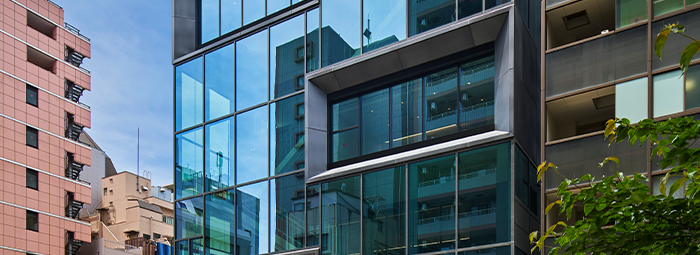
©2023 This excerpt taken from the article of the same name which appeared in ASHRAE Journal, vol. 65, no. 4, April 2023.
About the Authors
Nobuhiro Hirasuga and Shun Kato are both engineers at Mitsubishi Jisho Design Inc. in Tokyo. Takashi Akimoto, Ph.D., is a professor at Shibaura Institute of Technology in Tokyo. Yu Sakamoto is a man¬ager at Shinryo Corporation in Tokyo.
Shinryo Shinjo Building is a commercial rental office building completed in June 2020 in Chiyoda-ku, Tokyo. Two energy-saving air-conditioning systems, one convection and one radiant, were developed and installed in the same shaped floor and compared from multifaceted aspects. Both systems secure a standard ceiling height (2800 mm [9.1 ft]) with a limited floor height (3450 mm [11.3 ft] instead of the usual 4000 mm [13.1 ft]), allowing for adding more floors within local height restrictions. The convection system is a variable airflow system that uses the Coanda effect to deliver air to the entire room with 83% less fan power without ducts. The radiant system is a variable temperature/water volume control system designed to maximize use of free-cooling even when the outside air temperature is close to 30°C (86°F), depending on outdoor humidity.
Energy Efficiency
For heat sources, air source heat pump (ASHP) chillers were adopted. Two units are for cooler chilled water/ warmer hot water. Two other units are provided for the warmer chilled water/cooler hot water system. The warmer chilled water was introduced for the purpose of increasing the heat source efficiency and used for water radiant panels, air conditioner coils and others. In addition, cooling towers were installed in series with the heat sources for pre-cooling and free-cooling operation. The standard distribution temperature of warmer chilled water chillers is 16°C (61°F) minimum for the cooling season and 34°C (93°F) maximum in the heating season.
Read the Full Article
ASHRAE Members have free access to the full-text PDF of this article as well as the complete ASHRAE Journal archives back to 1997 in the Free Member Access Area.
Non-members can purchase features from the ASHRAE Bookstore. Or, Join ASHRAE!
Return to Featured Article Excerpts
Return to ASHRAE Journal Featured Article Excerpts